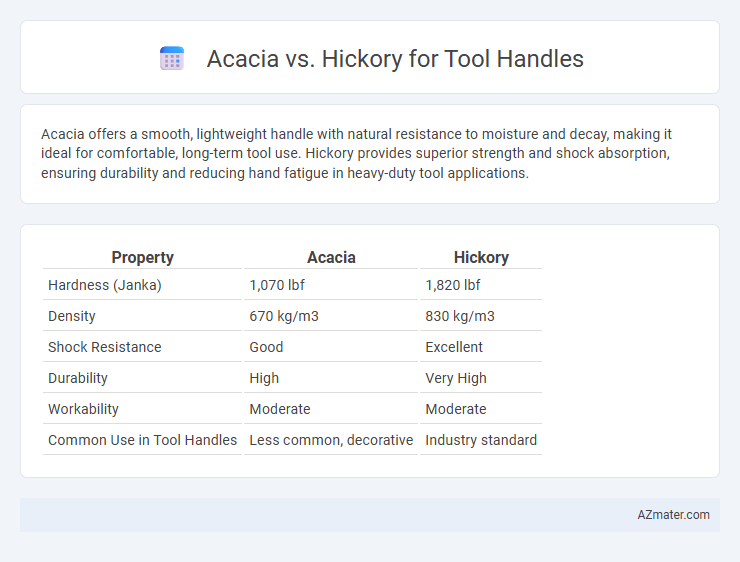Acacia offers a smooth, lightweight handle with natural resistance to moisture and decay, making it ideal for comfortable, long-term tool use. Hickory provides superior strength and shock absorption, ensuring durability and reducing hand fatigue in heavy-duty tool applications.
Table of Comparison
| Property | Acacia | Hickory |
|---|---|---|
| Hardness (Janka) | 1,070 lbf | 1,820 lbf |
| Density | 670 kg/m3 | 830 kg/m3 |
| Shock Resistance | Good | Excellent |
| Durability | High | Very High |
| Workability | Moderate | Moderate |
| Common Use in Tool Handles | Less common, decorative | Industry standard |
Introduction: Why Wood Choice Matters for Tool Handles
Choosing the right wood for tool handles is essential for durability, comfort, and performance, with Acacia and Hickory being popular options due to their strength and shock absorption. Acacia offers a dense, moisture-resistant structure ideal for longevity in humid conditions, while Hickory provides exceptional toughness and flexibility, making it a top choice for impact-heavy tools. Understanding the unique properties of Acacia and Hickory helps craftsmen select handles that reduce fatigue and enhance control during prolonged use.
Overview of Acacia and Hickory Wood
Acacia wood is known for its dense grain, high durability, and resistance to moisture, making it a strong and stable option for tool handles that require longevity and strength. Hickory wood, renowned for its exceptional toughness, shock resistance, and flexibility, is traditionally preferred for tool handles that endure heavy impact and frequent use. Both woods offer superior performance, but Acacia's natural oils provide enhanced water resistance, while Hickory's fibrous structure delivers outstanding shock absorption.
Strength and Durability Comparison
Acacia wood offers impressive strength with a Janka hardness rating of around 1,070, making it resistant to dents and wear for tool handles. Hickory surpasses Acacia in durability, boasting a Janka hardness of approximately 1,820 and exceptional shock resistance, which is vital for heavy-impact tools. The superior toughness and flexibility of Hickory make it a preferred choice for long-lasting, resilient tool handles.
Shock Absorption Capabilities
Acacia wood offers moderate shock absorption ideal for tool handles used in light to medium tasks, featuring a dense grain that balances strength and flexibility. Hickory outperforms Acacia in shock absorption due to its exceptional toughness and elasticity, making it the preferred choice for heavy-duty tools requiring high impact resistance. The superior shock absorption of Hickory reduces user fatigue and enhances control, benefiting professionals in demanding environments.
Weight and Balance Considerations
Acacia tool handles offer a lighter weight advantage, enhancing maneuverability during extended use, while hickory handles are denser and provide superior durability with a sturdier feel. The weight difference influences balance, as Acacia's lighter composition shifts the tool's center of gravity closer to the head, offering increased precision, whereas hickory's balanced mass distribution supports better control and impact absorption. Choosing between Acacia and hickory for tool handles depends on the user's preference for weight sensitivity and the need for lasting resilience in demanding tasks.
Resistance to Weather and Moisture
Acacia wood offers moderate resistance to weather and moisture, making it suitable for tool handles used in humid or slightly wet conditions. Hickory surpasses Acacia in durability and moisture resistance due to its dense grain and natural oils, providing enhanced protection against warping and cracking in variable weather. Choosing Hickory for tool handles ensures longer-lasting performance in outdoor or damp environments.
Workability and Ease of Shaping
Acacia wood offers moderate workability with a fine grain that allows for smooth shaping and finishing, making it ideal for detailed tool handles requiring precision. Hickory, known for its exceptional hardness and toughness, is more challenging to shape but provides superior shock resistance and durability in tool applications. Choosing between Acacia and Hickory depends on the balance needed between ease of crafting and the handle's strength during heavy use.
Cost and Availability
Hickory is typically more expensive and harder to source due to its limited growth regions and slower harvesting cycles, making it a premium choice for tool handles. Acacia offers a cost-effective alternative, widely available in tropical regions with faster growth rates, resulting in lower prices and more consistent supply. The economic advantage of Acacia is favored in large-scale production, while Hickory's higher cost reflects its superior shock absorption and durability for specialized tools.
Maintenance and Longevity
Acacia tool handles require regular oiling to maintain their natural resistance to moisture and prevent cracking, enhancing their durability over time. Hickory handles naturally resist shock and wear due to their dense, fibrous structure, needing minimal maintenance for long-term use. Both woods offer excellent longevity, but Hickory's superior strength and lower upkeep make it the preferred choice for heavy-duty tool handles.
Verdict: Which Wood Is Best for Your Needs?
Acacia offers exceptional durability, a smooth finish, and resistance to moisture, making it ideal for tool handles subjected to frequent handling and outdoor use. Hickory provides superior shock resistance and strength, delivering excellent comfort and control for heavy-duty applications and tools requiring high impact absorption. Choose Acacia for longevity and aesthetics in moderate tasks, but opt for Hickory when maximum toughness and impact resistance are crucial for your tool handles.

Infographic: Acacia vs Hickory for Tool Handle
 azmater.com
azmater.com